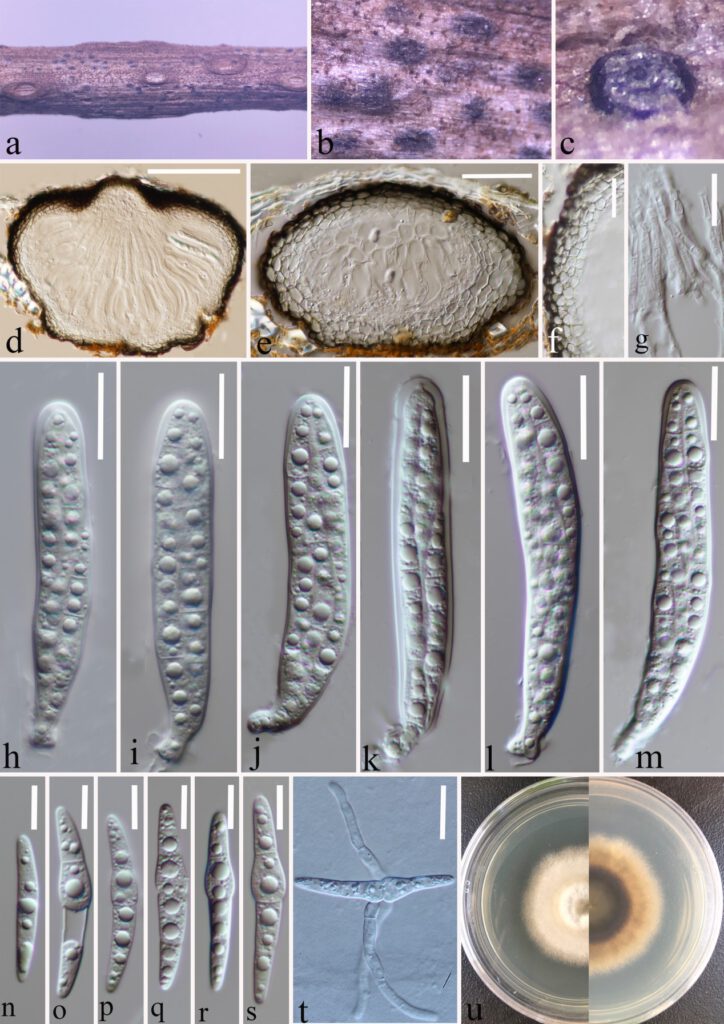Paraleptosphaeria kunmingensis Y. Gao, H. Gui & K.D. Hyde, sp. nov.
MycoBank number: MB; Index Fungorum number: IF; Facesoffungi numbers: FoF 12902; FIGURE 2 CCSG18.
Etymology: The specific epithet “kunmingensis” refers to Kunming city where the holotype was collected.
Holotype: HKAS 124662
Saprobic on decaying stalk of grass. Sexual morph: Ascomata 215–300 μm diam × 145–220 μm high (x̅ = 253 × 176 μm, n = 15), scattered, gregarious, immersed in the epidermis of the host, globose or subglobose and flat-globose, dark brown to black, uni-loculate, glabrous, shiny, papillate, without ostiole. Peridium (21–)24–34(–43) μm thick, (x̅ = 29 μm, n = 35), composed of 2–4 layers of flattened, light brown to dark brown cells of textura angularis. Hermathecium (1.6–)2–3(–3.7) μm wide, (x̅ = 2.5 μm, n = 40), straight, septate, hyaline, unbranched, cellular pseudoparaphyses, embedded in a gelatinous matrix. Asci (70–)73–92(–104) × (12–)13–15.7(–16.4) μm (x̅ = 83 × 14 μm, n = 25), 8-spored, arising from base, bitunicate, fissitunicate, cylindrical to cylindric-clavate, short pedicellate with club-like pedicel, thick-walled at the apex, hyaline, with ocular chamber. Ascospores (33.5–)37.6–47(–50.5) × (5–)5.2–6.2(–7.2) μm (x̅ = 42.3 × 5.7 μm, n = 30), overlapping, 2–3-seriate, hyaline, guttulate, lunate to long fusiform or inequilateral, straight or slightly curved, with 1–3 transverse septa, often slightly constricted at medium septum, widest at the middle, rounded to slightly pointed at both ends, without mucilaginous sheath. Asexual morph: Undetermined.
Culture characteristics: Ascospores germinated on PDA within 20 hours and a germ tube initially produced from the middle. Colonies on PDA reaching 15 mm in 2 weeks at room temperature (15–27℃), circular, slightly raised, curled, floccose, pale yellow from the above, dark brown in the center gradually pale yellow towards the edges from the below, grows towards the filamentous edge.
Material examined: CHINA, Yunnan Province, Kunming city, (25°8’19”N, 102°44’25”E), on decaying stalk of herbaceous plant, 20 June 2021, Ying Gao, CCSG18 (HKAS 124662, holotype), ex-type living culture, XXX.
Note: Paraleptosphaeria kunmingensis (HKAS 124662 holotype) is introduced as a new species based on its distinct morphology and analysis of a combined SSU, LSU, ITS, tub2 and rpb2 dataset. Paraleptosphaeria kunmingensis clusters close to Paraleptosphaeria macrospora (CBS114198) with 87 % ML and 1.00 BYPP bootstrap support (Fig. 1). Our species differs from P. macrospora (Basionym: Metasphaeria macrospora) in asci and ascospores morphology (Saccardo 1883, Gruyter et al. 2013). Paraleptosphaeria kunmingensis differs P. macrospora in smaller asci (83 × 14 μm vs. 105 × 18 μm), smaller ascospores (42.3 × 5.7 μm vs. 44 × 8 μm), the number of septa of ascospores (1–3-septa vs. 3-septa). In addition, a nucleotide pairwise comparison showed that Paraleptosphaeria kunmingensis differs from Paraleptosphaeria macrospora (CBS 114198) in 18/523 bp of ITS (3.44 %). And differs from Paraleptosphaeria nitschkei (CBS 306.51) in 18/523 bp of ITS (3.44 %), 23/332 bp of tub2 (6.93 %), 46/599 bp of rpb2 (7.68 %). Therefore, following the guidelines for species delineation described by Jeewon and Hyde (2016), we introduce Paraleptosphaeria kunmingensis as a novel taxon.

FIGURE2 Paraleptosphaeria kunmingensis (HKAS 124662 holotype) on decaying stalk of herbaceous plant. a–c. Ascomata on the host. d, e. Vertical section of the ascoma. f. Peridium. g. Hermathecium. h–m. Asci. n–s. Ascospores. t. Germinating ascospore. u. front and reverse colony on PDA. Scale bars: d = 100 μm, e = 50 μm, f = 30 μm, g–m = 10 μm, n–s = 10 μm, t = 20 μm.
